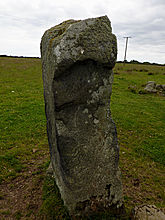|
|
|
|
Crousa Common MenhirsStanding Stone / Menhir
|
||||||||||||||||||||||||
|
|
|
Images (click to view fullsize) |
|









|
Folklore |
|
|
Slimmed down a little from: Robert Hunt's "The Crowza Stones." "Popular Romances of the West of England. Volume 2". 1903. St Just, from his home in Penwith, being weary of having little to do, except offering prayers for the tinners and fishermen, went on a visit to the hospitable St Keverne, who had fixed his hermitage in a well-selected spot, not far from the Lizard headland. St Just gloried in the goodly chalice from which he drank the richest of wines, and envied St Keverne the possession of a cup of such rare value. Again and again did he pledge St Keverne; their holy bond of brotherhood was to be for ever. The time came when St Just felt he must return to his flock; he departed. St Keverne sending many a blessing after his good brother. St Just had not long left before St Keverne missed his cup. Diligent search was made in every corner of his dwelling, but no cup could be found. At length St Keverne could not but feel that he had been robbed of his treasure by his friend. His rage was excessive. St Keverne felt that his wisest course was to pursue the thief inflict summary punishment on him, and recover his cup. St Keverne started in pursuit of St Just. Passing over Crowza Down, some of the boulders of "Ironstone" which are scattered over the surface caught his eye, and presently he whipped a few of these stone pebbles into his pockets, and hastened onward. Near Tre-men-keverne he spied St Just. St Keverne worked himself up into a boiling rage, and toiled with increased speed up the hill, hallooing to the saintly thief; who pursued his way for some time in the well-assumed quiet of conscious innocence. Long and loud did St Keverne call on St Just to stop, but the latter was deaf to all calls of the kind and on he went, quickening a little. At length St Keverne came within a stone's throw of the culprit, and calling him a thief and adding some of the most choice epithets from his holy vocabulary. Taking a stone from his pocket, he let it fly after St Just. The stone falling heavily by the side of St Just, convinced him making all the use he could of his legs. He quietly untied the chalice, which he had fastened to his girdle, and let it fall to the ground. St Keverne came up to where his cup glistened in the sunshine. He had recovered his treasure. Therefore he took, one by one, the stones from his pockets--he hurled them, fairly aimed, after the retreating culprit, and cursed him as he went. There the pebbles remained where they fell, the peculiarity of the stone being in all respects unlike anything around, but being clearly the Crowza stones, attesting the truth of the legend; and their weights, each one 'being several hundred pounds, proving the power of the giant saint. |
28th March 2005ce |
Miscellaneous |
|
|
Two granite longstones , one standing one fallen.about 5 metres apart. Local legend says that if the stones were ever removed then they would return overnight |
Posted by phil 2nd December 2001ce Edited 24th March 2013ce |

